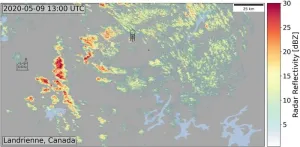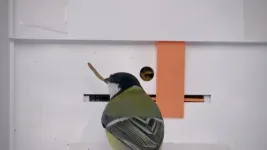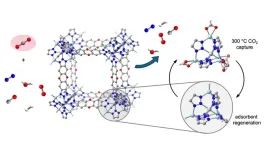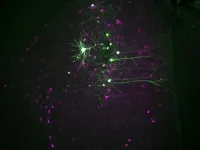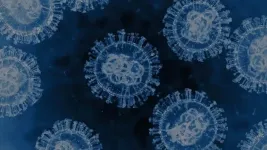(Press-News.org) Pollution from industrial hotspots can trigger ice formation in supercooled clouds, altering their reflective properties and increasing regional snowfall, according to a new study. The findings shed light on poorly understood impacts of anthropogenic aerosols on climate and could help improve climate modeling and mitigation strategies. The impact of human-generated aerosols (tiny air pollution particles) on climate, particularly in counteracting greenhouse gas-induced warming, remains uncertain. These aerosols, in addition to influencing cloud formation as cloud condensation nuclei (CCN), may also act as ice-nucleating particles (INPs), crucial for ice formation in supercooled liquid-water clouds at temperatures above -36 °degrees Celsius (°C). Anthropogenic INPs have been proposed to explain the plume-shaped snowfall patterns observed downwind of industrial sites, where emissions of heat, water vapor, and particles can influence cloud formation. However, a lack of observational evidence has prevented accurate assessment of the role of anthropogenic INPs in ice formation – or glaciation – of supercooled clouds and its potential impact on cloud cover and radiative fluxes. Using remote sensing data, including near-infrared satellite images from the satellite-based Moderate Resolution Imaging Spectroradiometer (MODIS) instrument, Velle Toll and colleagues observed the glaciation of supercooled clouds downwind of 67 aerosol-emitting industrial sites, such as metal and cement factories, paper mills, and powerplants. Toll et al. found that cloud glaciation from industrial aerosols, logged at various facilities in Canada and Russia, reduces solar radiation reflection by 13.7%, cloud cover by 8.3%, and cloud optical thickness by 18% while enhancing infrared radiance by 4.2% compared to unaffected clouds nearby. Additionally, the authors found that glaciation-induced snowfall greatly impacted local precipitation, with daily accumulations reaching up to 15 millimeters (mm), despite an average snowfall rate of 1.2 mm per hour, highlighting a measurable effect of industrial aerosols on localized snowfall patterns. The findings suggest that glaciation from anthropogenic ice-nucleating particles (INPs) could mirror the effects of pollution tracks in liquid clouds, highlighting the need for further investigation into the precise impact of anthropogenic INPs on cloud properties and climate. Additionally, rare glaciation events near nuclear power plants suggest factors other than INPs may also influence glaciation, such as local lofting of nearby aerosols by warm plumes.
END
Industrial air pollution triggers ice formation in clouds, reducing cloud cover and boosting snowfall
Summary author: Walter Beckwith
2024-11-14
ELSE PRESS RELEASES FROM THIS DATE:
Emerging alternatives to reduce animal testing show promise
2024-11-14
In a Policy Forum, Chad Nelson and colleagues highlight the efforts of the U.S. Food and Drug Administration (FDA) in advancing alternative methods to reduce animal testing for regulatory use. Animal studies have been crucial for advancing disease understanding, developing therapies, and assessing the safety and effectiveness of consumer products. However, reducing animal use and developing effective alternatives is an ongoing priority. Although advances in biology, engineering, and artificial intelligence offer new opportunities to improve product safety assessments, these technologies require extensive development to meet regulatory ...
Presenting Evo – a model for decoding and designing genetic sequences
2024-11-14
A new study presents “Evo” – a machine learning model capable of decoding and designing DNA, RNA, and protein sequences, from molecular to genome scale, with unparalleled accuracy. Evo’s ability to predict, generate, and engineer entire genomic sequences could change the way synthetic biology is done. “The ability to predict the effects of mutations across all layers of regulation in the cell and to design DNA sequences to manipulate cell function would have tremendous diagnostic and therapeutic implications for disease,” writes Christina Theodoris ...
Global plastic waste set to double by 2050, but new study offers blueprint for significant reductions
2024-11-14
Without intervention, global plastic waste could double by 2050, a new machine learning study predicts. However, according to simulations by the study’s authors, a mix of policy interventions could cut plastic waste by more than 90% and it could cut plastics-related emissions by a third. With UN treaty negotiations underway, these findings provide a crucial blueprint for tackling the plastic crisis. Plastic production has increased relentlessly for decades, leading to surging plastic waste generation and environmental mismanagement. As plastic ...
Industrial snow: Factories trigger local snowfall by freezing clouds
2024-11-14
Anthropogenic aerosols, tiny solid and liquid air pollution particles, have masked a fraction of global warming caused by anthropogenic greenhouse gases. Climate researchers have known for decades that anthropogenic aerosols perturb liquid clouds by enabling the formation of a larger number of cloud droplets, making clouds brighter. A new landmark study led by the University of Tartu suggests that anthropogenic aerosols may also influence clouds by converting cloud droplets to ice at temperatures below zero degrees Celsius.
Powerplant Snow
Using satellite observations, climate researchers discovered unique plumes of ice clouds and reduced cloud cover downwind of industrial hot spots ...
Backyard birds learn from their new neighbors when moving house
2024-11-14
Scientists have found a trigger for social learning in wild animals. An experiment on great tits has pinpointed a single factor—immigration—that can cause birds to pay close attention to others, leading them to rapidly adopt useful behaviors. The study is the first to provide experimental support of a long-held assumption that immigrants should strategically use social learning. The study, conducted by scientists from the Max Planck Institute of Animal Behavior (MPI-AB) and the Cluster of Excellence Collective Behaviour at the University of Konstanz in Germany, is published November 14 in PLOS Biology.
Many animals that live in groups learn from one another, but few ...
New study in Science finds that just four global policies could eliminate more than 90% of plastic waste and 30% of linked carbon emissions by 2050
2024-11-14
Berkeley, CA/Santa Barabara, CA (14 November 2024) — A new study released in Science today determines that just four policies can reduce mismanaged plastic waste — plastic that isn’t recycled or properly disposed of and ends up as pollution — by 91% and plastic-related greenhouse gasses by one-third. The policies are: mandate new products be made with 40% post-consumer recycled plastic; cap new plastic production at 2020 levels; invest significantly in plastic waste management — such as landfills and waste collection services; and implement a small fee on plastic packaging. ...
Breakthrough in capturing 'hot' CO2 from industrial exhaust
2024-11-14
Industrial plants, such as those that make cement or steel, emit copious amounts of carbon dioxide, a potent greenhouse gas, but the exhaust is too hot for state-of-the-art carbon removal technology. Lots of energy and water are needed to cool the exhaust streams, a requirement that has limited adoption of CO2 capture in some of the most polluting industries.
Now, chemists at the University of California, Berkeley, have discovered that a porous material can act like a sponge to capture CO2 at temperatures close to those of many industrial exhaust streams. ...
New discovery enables gene therapy for muscular dystrophies, other disorders
2024-11-14
Gene therapy can effectively treat various diseases, but for some debilitating conditions like muscular dystrophies there is a big problem: size. The genes that are dysfunctional in muscular dystrophies are often extremely large, and current delivery methods can’t courier such substantial genetic loads into the body. A new technology, dubbed “StitchR,” surmounts this obstacle by delivering two halves of a gene separately; once in a cell, both DNA segments generate messenger RNAs (mRNAs) that join seamlessly together to restore expression of a protein that is missing or inactive in disease.
Published in ...
Anti-anxiety and hallucination-like effects of psychedelics mediated by distinct neural circuits
2024-11-14
New research suggests that it could be possible to separate treatment from hallucinations when developing new drugs based on psychedelics. The anti-anxiety andhallucination-inducing qualities of psychedelic drugs work through different neural circuits, according to research using a mouse model. The work is published Nov. 15 in Science.
The research shows that decoupling the beneficial effects of psychedelics from their hallucinogenic effects isn’t just a matter of chemical compound design. It’s a matter of targeted neural circuitry.
“In the past, we did this using chemistry by making new compounds, but here we focused on identifying the circuits responsible ...
How do microbiomes influence the study of life?
2024-11-14
UNIVERSITY PARK, Pa. — Microorganisms — bacteria, viruses and other tiny life forms — may drive biological variation in visible life as much, if not more, than genetic mutations, creating new lineages and even new species of animals and plants, according to Seth Bordenstein, director of Penn State’s One Health Microbiome Center, professor of biology and entomology, and the Dorothy Foehr Huck and J. Lloyd Huck Endowed Chair in Microbiome Sciences. Bordenstein and 21 other scientists from around the world published a paper in the leading journal Science, summarizing research that they said drives a deeper understanding of biological ...
LAST 30 PRESS RELEASES:
Sleeping in on weekends may help boost teens’ mental health
Study: Teens use cellphones for an hour a day at school
After more than two years of war, Palestinian children are hungry, denied education and “like the living dead”
The untold story of life with Prader-Willi syndrome - according to the siblings who live it
How the parasite that ‘gave up sex’ found more hosts – and why its victory won’t last
When is it time to jump? The boiling frog problem of AI use in physics education
Twitter data reveals partisan divide in understanding why pollen season's getting worse
AI is quick but risky for updating old software
Revolutionizing biosecurity: new multi-omics framework to transform invasive species management
From ancient herb to modern medicine: new review unveils the multi-targeted healing potential of Borago officinalis
Building a global scientific community: Biological Diversity Journal announces dual recruitment of Editorial Board and Youth Editorial Board members
Microbes that break down antibiotics help protect ecosystems under drug pollution
Smart biochar that remembers pollutants offers a new way to clean water and recycle biomass
Rice genes matter more than domestication in shaping plant microbiomes
Ticking time bomb: Some farmers report as many as 70 tick encounters over a 6-month period
Turning garden and crop waste into plastics
Scientists discover ‘platypus galaxies’ in the early universe
Seeing thyroid cancer in a new light: when AI meets label-free imaging in the operating room
Neutrophil-to-lymphocyte ratio may aid risk stratification in depressive disorder
2026 Seismological Society of America Annual Meeting
AI-powered ECG analysis offers promising path for early detection of chronic obstructive pulmonary disease, says Mount Sinai researchers
GIMM uncovers flaws in lab-grown heart cells and paves the way for improved treatments
Cracking the evolutionary code of sleep
Medications could help the aging brain cope with surgery, memory impairment
Back pain linked to worse sleep years later in men over 65, according to study
CDC urges ‘shared decision-making’ on some childhood vaccines; many unclear about what that means
New research finds that an ‘equal treatment’ approach to economic opportunity advertising can backfire
Researchers create shape-shifting, self-navigating microparticles
Science army mobilizes to map US soil microbiome
Researchers develop new tools to turn grain crops into biosensors
[Press-News.org] Industrial air pollution triggers ice formation in clouds, reducing cloud cover and boosting snowfallSummary author: Walter Beckwith
